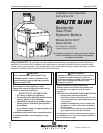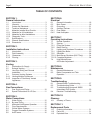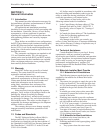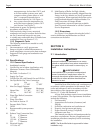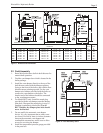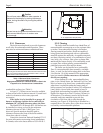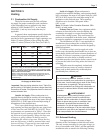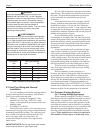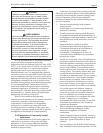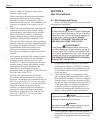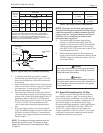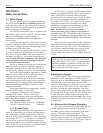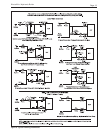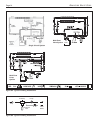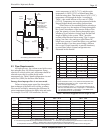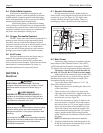
Brute Mini Hydronic Boiler
Page 7
SECTION 3.
Venting
3.1 Combustion Air Supply
The boiler location must provide sufficient
air supply for proper combustion, and ventilation
of the surrounding area as outlined in the latest
edition of ANSI standard Z223.1 or in Canada,
CSA-B149.1, and any local codes that may be
applicable.
In general, these requirements specify that boiler
rooms which represent confined spaces should be
provided with two permanent air supply openings; one
within 12 inches (305mm) of the ceiling, the other
within 12 inches (305mm) of the floor (see Table 2).
Inside Air Supply: When combustion is
supplied from inside the building, each opening should
have a minimum free area of one square inch per 1,000
BTU/h (0.3kW) input of the total input rating of all
appliances in the enclosed area. These openings
should never be less than 100 square inches
(645 sq. cm).
Note: In Canada, follow Canadian Standard, CSA-
B149.1 or local codes.
Exhaust Fans or Vents: Any equipment which
exhausts air from the boiler room can deplete the
combustion air supply or reverse the natural draft
action of the venting system. This could cause flue
products to accumulate in the boiler room. Additional
air must be supplied to compensate for such exhaust.
The information in Table 2 is not applicable in
installations where exhaust fans or blowers of any
type are used. Such installations must be designed by
qualified engineers.
If a blower or fan is used to supply air to the
boiler room, the installer should make sure it does not
create drafts which could cause nuisance shutdowns of
the pilot. If a blower is necessary to provide adequate
combustion air to the boiler, a suitable switch or
equivalent must be wired into the boiler control circuit
to prevent the boiler from firing unless the blower is
operating.
The boiler must be completely isolated and
protected from any source of corrosive chemical
fumes such as those emitted by trichlorethylene,
perchlorethylene, chlorine, etc.
WARNING
Do not store any chemical, cleaners, or other
corrosive material near combustion air openings or
in the room. Avoid locating dryer vents in the vicinity
of combustion air openings. Failure to prevent
corrosive materials from mixing with combustion air
can result in reduced boiler life and unsafe boiler
operation.
AVERTISSEMENT
N’entrepposer aucun produit chimique, produit
nettoyant ou produit corrosif à proximité des
bouches d’air de combustion ou dans la pièce.
Éviter de placer des tuyaux de ventilation pour
sécheuse à proximité des bouches d’air de
combustion. Le fait de laisser des maitières
corrosives se mélanger à l’air de combustion risque
de réduire le cycle de vie de l’appareil de chauffage
et de compromettre son fonctionnement.
3.2 Exhaust Venting
Vent piping must be of the same or larger
diameter as the vent damper or draft diverter outlet.
The only correct procedure for vent pipe sizing is to
do so in accordance with Table 3 and the applicable
installation code as stated in the following warning.
Boiler Size
Outside Air
Area in Sq. In.*
Inside Air
Area in Sq. In.* (sq cm)
50 15
97
100 645
75 20
129
100 645
100 25
161
100 645
125 32
206
125 807
160 40
258
160 1032
225 60
387
225 1452
*Area indicated is for one of two openings; one at floor level and
one at the ceiling, so the total net free area would be double the
figures indicated. For special conditions, refer to NFPA54 ANSI
Z223.1. In Canada refer to the National Standard CSA B149.1
which differs from this table.
NOTE: Check with louver manufacturers for Net Free Area of
louvers. Correct for screen resistance to the Net Free Area if a
screen is installed. Check all local codes applicable to
combustion air.
Table 2. Minimum Recommended
Air Supply to Boiler Room.
Outside Air Area*
Sq. In. sq cm
Inside Air Area*
Sq. In. sq cm
Important: See gas piping selection chart, Table 3 for
gas line sizing. In all cases, pipe size is larger than inlet
connection on heater. Run pipe size shown in chart and
reduce at heater inlet.
Outside Air Supply: When combustion air is
supplied directly through an outside wall, each opening
should have a minimum free area of one square inch per
4,000 BTU/h (1.2kW) input of the total input rating of
all appliances in the enclosed area.
If air is provided through horizontal ducts,
each opening and duct must provide one square inch
of flow area for each 2000 BTU/h (0.6 kW). These
requirements are summarized in Table 2. Note that
the required size of openings shall be based on the
net free area of each opening. Where the free area
of louver or grille is known it shall be used in
calculating the effective free area. Where the free
area are not known, it shall be assumed that wood
louvers will have 25 percent free area, and metal
louvers and grilles will have 75 percent free area.



